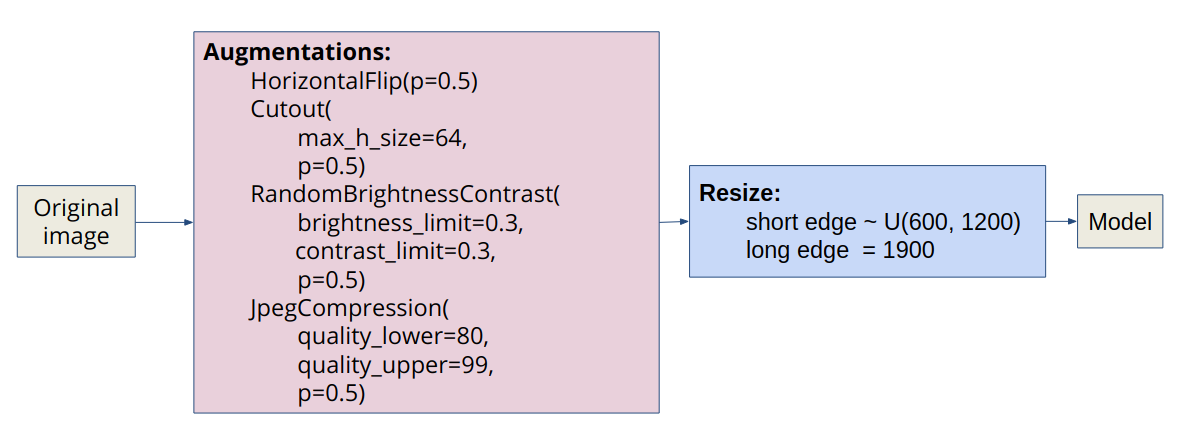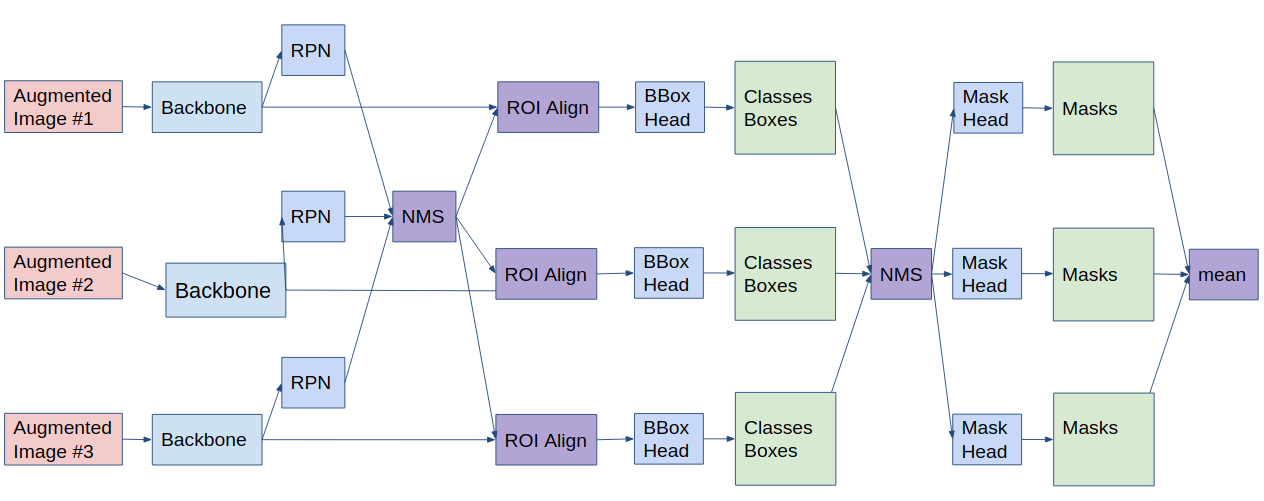The First Place Solution of iMaterialist (Fashion) 2019
My solution is based on the COCO challenge 2018 winners article: https://arxiv.org/abs/1901.07518.
Hybrid Task Cascade with ResNeXt-101-64x4d-FPN backbone. This model has a metric Mask mAP = 43.9 on COCO dataset. This is SOTA for instance segmentation.
For validation, I used 450 training samples splitted using https://github.com/trent-b/iterative-stratification.
I applied light augmentatios from the albumentations library to the original image. Then I use multi-scale training: in each iteration, the scale of short edge is randomly sampled from [600, 1200], and the scale of long edge is fixed as 1900.
- pre-train from COCO
- optimizer:
SGD(lr=0.03, momentum=0.9, weight_decay=0.0001) - batch_size: 16 = 2 images per gpu x 8 gpus Tesla V100
- learning rate scheduler:
if iterations < 500:
lr = warmup(warmup_ratio=1 / 3)
if epochs == 10:
lr = lr ∗ 0.1
if epochs == 18:
lr = lr ∗ 0.1
if epochs > 20:
stop
- training time: ~3 days.
After the 12th epoch with the default parameters, the metric on LB was 0.21913. Next, I tuned postprocessing thresholds using validation data:
rcnn=dict(
score_thr=0.5,
nms=dict(type='nms', iou_thr=0.3),
max_per_img=100,
mask_thr_binary=0.45
)
This improved the metric on LB: 0.21913 -> 0.30011.
I use 3 scales as well as horizontal flip at test time and ensemble the results. Testing scales are (1000, 1600), (1200, 1900), (1400, 2200).
I drew a TTA scheme for Mask R-CNN, which is implemented in mmdetection library. For Hybrid Task Cascade R-CNN, I rewrote this code.
This improved the metric on LB: 0.30011 -> 0.31074.
I ensemble the 3 best checkpoints of my model. The ensemble scheme is similar to TTA.
This improved the metric on LB: 0.31074 -> 0.31626.
I didn't use attributes at all: they were difficult to predict and the removal of classes with attributes greatly improved the metric.
During the whole competition, I deleted classes with attributes: {0, 1, 2, 3, 4, 5, 6, 7, 8, 9, 10, 11, 12} U {27, 28, 33}. But two days before the end I read [the discussion] (https://www.kaggle.com/c/kaggle-imaterialist-fashion-2019-FGVC6/discussion/94811#latest548137) and added back classes {27, 28, 33 }.
This improved the metric on LB: 0.31626 -> 0.33511.
My post-processing algorithm for avoid intersections of masks of the same class:
def hard_overlaps_suppression(binary_mask, scores):
not_overlap_mask = []
for i in np.argsort(scores)[::-1]:
current_mask = binary_mask[..., i].copy()
for mask in not_overlap_mask:
current_mask = np.bitwise_and(current_mask, np.invert(mask))
not_overlap_mask.append(current_mask)
return np.stack(not_overlap_mask, -1)I deleted objects with an area of less than 20 pixels.
This improved the metric on LB: 0.33511 -> 0.33621.
make build
make run-[server-name]
make execcd mmdetection
bash compile.sh
python setup.py developbash prepare_weights.sh/data/
├── train/
│ └── ...
├── test/
│ └── ...
└── train.csv.zip
/dumps/
└── htc_dconv_c3-c5_mstrain_x101_64x4d_fpn_20e_1200x1900/
Fix the error in train.csv.zip.
cd scripts
bash create_mmdetection_train.sh
bash create_mmdetection_test.sh
bash split.shCUDA_VISIBLE_DEVICES=[list of gpus] bash dist_train.sh [config] [gpus] [--validate] https://yadi.sk/d/-raqliq_ad6r_Q
CUDA_VISIBLE_DEVICES=[list of gpus] bash dist_test_ensemble.sh [config] [gpus]


